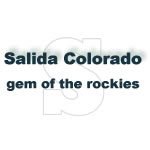

| Chaffee County Mining History |
Salida Record, Oct. 6, 1903: All of the furnaces excepting one at the Ohio & Colorado Smelting & Refining Company smelter are idle today on account of a walk out of the employees. A few men remained and the management is keeping the one furnace going full blast. The strike has been expected for several days. Its cause is the changing from the eight hour day to the twelve hour day. Conferences were held between representatives of the employees and the management but no agreement could be effected and the men walked out. There was no disturbance whatever and so far there is not the slightest indication of any. Before quitting the men drew the fires so that there is no injury to the plant. They have no complaint to make against the management as to treatment or conditions, save that they will no accept the new wage terms as offered. Salida Mail, March 18, 1904: Mr. G. DeLage has this week
returned from the east, where he has been organizing a company for the operation
of the New York group of claims near Romley, in the Chalk Creek district. The
New York group of claims is considered to be a valuable property and the company
is expecting to make a shipment of ore within a few days. Salida Mail, April 22, 1904: A smelter employee suffering from lead poisoning was taken in charge by the County Physician Cochems the first of the week and placed in the Red Cross Hospital for treatment. Later he became so violent that it was necessary that he should be removed to some place of safer keeping and was taken to the city jail, where he was held until he could be removed to the county hospital. Salida Record, April 23, 1904: W. H. Covey was down from Whitehorn yesterday and reported that the recent strike made in the Last Chance looked better than ever. A 4,000-pound block of seventy-dollar ore from this property will be exhibited at the St. Louis fair. Salida Record, April 30, 1904: L. L. Covey, superintendent of the Last Chance mine at Whitehorn was quite badly injured by a falling rock Tuesday morning. Fortunately, the rock did not strike Mr. Covey in a vital spot or the injury would have been more serious than it was. Mr. Covey will be back at work within a few days Salida Record, May 5, 1904: Chas. Fowler has within the last few days discovered a bed of hot water crystals within a short distance of the city. Several beautiful specimens are on exhibition at the Board of Trade and at the Chesapeake Restaurant. Salida Record, June 27, 1904: A. N. Denyers of Pueblo, representing a heavy mining syndicate, passed through Salida this week en route to Monarch. Mr. Denyers was accompanied by a force of men who will be put to work opening up a new discovery of high grade ore in that district. Mr. Denyers is indirectly connection with the steel works at Pueblo. A smelter test made of the ore from the property which this syndicate is to take hold of gives a return of $87 per ton, so it the deposit is anything like as large as believed the new property represents a most valuable proposition. Salida Mail, March 7, 1928: John Nigro, who is operating the lime quarry at Wellsville, where his father, Frank Nigro and a workman recently were blown up and killed in an explosion of a buried bomb, reported to the police yesterday that thieves had carried away a jack hammer valued at $250 besides a number of sledge hammers and loading forks. The thieves also drained the oil out of the crankcase of the truck and filled it with water. The quarry was forced to suspend operations because of the theft of the jack hammer. The police have a clue to the culprits. Salida Mail, Oct. 29, 1928: Mount Princeton granite, which is quarried at Mount Princeton in this county will be used in the construction of the new county and city building in Denver. A telegram was received yesterday in Salida from Mr. Milne, a granite dealer of Denver, stating that Varnum & Bates, who had been awarded the contract on the lowest bid, did not furnish bond in the required time, and the contract will go to Peter Seerie who is one of the owners of the Mount Princeton quarry. In order to get the granite out it may be deemed advisable to reconstruct the narrous gauge railroad from Nathrop to Mount Princeton. The quarrying will give work to a large number of men for a long time. This may be the means of establishing the quarry on a permanent basis of heavy production because the use of the granite in the Denver building will give the stone wide advertising. The construction of the new building is to be started in a few weeks. Salida Mail, Feb. 12, 1929: Marble quarries between Salida and Wellsville have a greater variety of colors than any marble in any other place in the world. it is taking precedence over Italian and Belgium marble and the demand at present is greater than the output. This is the statement of Roland Winburn, mining engineer, who is in charge of the U. S. marble company quarries on the North side of the river at Wellsville. Mr. Winburn has been developing the quarries for three years and he spends much of his time in Salida. he is employing only four men at the quarry and four at a factory in Canon City where the marble is crushed, molded in cement and polished into high class flooring and interior decorating material. Salida Mail, April 30, 1929: Ten men are now employed in the plant of the Mount Cross Granite Company and more will be added from time to time as the supply of stone increases. The company is now hauling stone from its quarries over the Cottonwood Gulch road but a permanent road will be in Ute Gulch. Two carloads of stone are now awaiting shipment. The machinery in the plant is steadily increasing in output. Forty men will be employed in the plant when it is operated at full capacity. Salida Mail, May 13, 1953: Zirconium ore has been discovered east of Salida on property owned by Commercial Minerals, Inc., a locally-owned corporation, Frank Mansheim, field manager, announces. The zirconium ore was found to be associated with feldspar, biotite and calcite. The sampling and detail work was furnished by the U.S. Bureau of Mines. Mansheim says, "We have a thirty foot shaft sunk on the property and numerous trenches show considerable ore in place. The property, no doubt, will be turned to a large industrial firm that has the resources and the know-how to undertake the venture. We are strictly a prospecting company." The Mountain Mail, July 31, 1978: The initial plans of the Ohio and Colorado Smelting and Refining Co. began in 1902 on Jan. 11, and exactly 74 years later on January 11, the Salida Smelter was listed on the National Register as a landmark.Now owned by the Salida Museum Association, the smokestack is truly an incredible visual site, as much as it is a storehouse of history. According to State Historical Society officials, the huge column is the only one of its kind left standing in the state, and Salida Museum Association President Judy Micklich, says that steps are being taken to put an eight foot chain link fence around the stack to help with its preservation. The Mountain Mail, March 18, 1979: When expansion work at Calco, Inc., of Salida is completed in about three months, the firm expects to more than quadruple its present work force of seven people.Extensive renovation work at the plant costing in excess of $2 million is expected to be done by this summer. The plant is located on the east side of the Arkansas River across from Salida Hospital. When the calcium carbonate processing plant gets into full operation it is expected to employ up to 30 people. Plant foreman Roy Hicks said Calco will operated seven days a week around the clock. Production is expected to climb from the present 75 tons per day to more than 240 tons daily. The Mountain Mail, July 20, 1979: The Cubs of Den 8 headed up Monarch to tour the Madonna Mine. While waiting for the train, the boys examined rocks in the tailings pile, rocks on display, the stuffed animals and old mining tools. After putting on hard hats, they rode the train a quarter-mile into the mine, which they found chilly after the summer weather. The running water surprised them and they asked many questions about it. The train stopped to show the hand tools, and they learned how the miners set the powder and loaded the ore cars for the mules to pull out. At the next stop, they looked at the old hoist and cage where ore cars were brought up from lower levels. |
| Old Newspaper Articles from Chaffee County | |||||
| Mining | Railroad | Ranching | Industry | Wildlife | |
| Fire & Water | Governement | Recreation | People | Events | |
